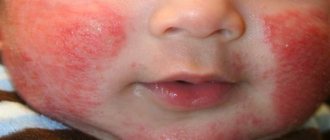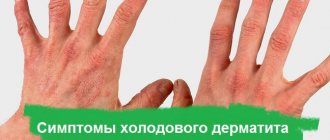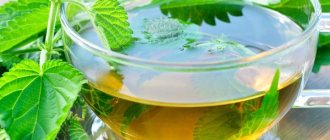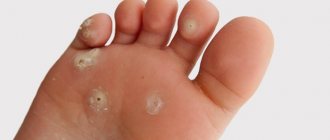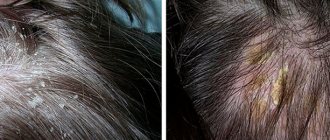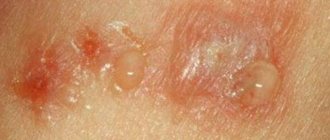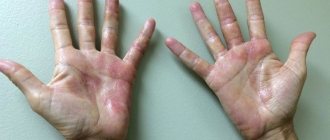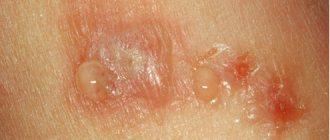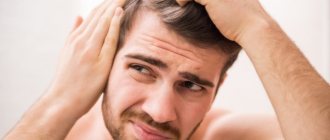More about the origin of the disease
Photos with symptoms of dermatitis on the legs of adults and children are a clear reflection of inflammatory processes in the layers of the epidermis and deeper layers. There are many factors that can trigger such processes. Most often, treatment of dermatoses is required due to interaction with allergens.
How to cure dermatitis on the legs?
With the right approach, getting rid of dermatitis will not be difficult. Conventionally, all treatment of dermatitis can be divided into several parts.
Avoiding contact with the allergen
The very first step to getting rid of dermatitis should be to avoid contact with the allergen, including getting rid of mechanical irritants, especially if they are the cause of the skin lesion.
In other words, at least for the period of treatment , synthetic trousers, tights, stockings and socks will have to be abandoned . To wash clothes, you should use powders that do not contain phosphates and their derivatives.
In addition, patients with dermatitis should follow a diet that excludes highly allergenic foods.:
- coffee;
- chocolate;
- citrus;
- nuts;
- seafood;
- marinades;
- smoked meats;
- mayonnaise;
- spices;
- spices;
- strawberry;
- pineapples;
- melons;
- tomatoes;
- honey;
- chicken eggs;
- mushrooms;
- eggplants.
List of allergen products
In addition, nickel-containing products can provoke further development of dermatosis on the legs :
- millet;
- oatmeal;
- lentils;
- soy;
- liver;
- sunflower seeds.
Nickel-rich foods
Antihistamines
In addition, antihistamines are used to treat leg dermatitis. Medicines from this group can be used in various forms.
The most popular antihistamines are:
- Suprastin;
- Tavegil;
- Zyrtec;
- Zodak;
- Telfast.
Topical corticosteroid ointments
To eliminate unpleasant symptoms in the acute period of the disease, hormonal gels, creams and ointments are most often used.
- Advantan;
- Lokoid;
- Elidel.
After the acute phase is removed, the skin especially needs to be applied topically with salicylic or boric petroleum jelly . For swelling of the affected areas, baths or lotions with weakly concentrated boric acid are recommended.
Desensitizing drugs
In the acute phase of dermatosis, desensitizing drugs are often prescribed in the form of intramuscular or intravenous injections of calcium gluconate.
Vitamin and autohemotherapy
Properly structured vitamin therapy can:
- improve skin condition;
- speed up metabolic processes (speed up healing);
- help improve the functioning of internal organs.
As a rule, vitamin therapy for leg dermatosis consists of the use of a complex of vitamins: A, C, E, D and B.
Autohemotherapy is also used to improve immunity and is a course of physiotherapeutic procedures.
If a diagnosis of neurodermatitis is made, the following medications are also prescribed: taking sedatives and consulting a psychologist.
To relieve inflammation, especially if the affected area is large enough, antibiotics may be prescribed .
More about the reasons
The first reason shown in the photo with signs of skin dermatitis on the legs of adults and children is heredity. Failure of the immune system, nervous disorders, disturbances of intestinal microflora, and direct interaction with allergens can contribute to the development of the disease.
Why does dermatitis appear on the legs?
Many factors can trigger the development of dermatitis, but all possible causes can be divided into two groups: exogenous (external) and endogenous (internal).
Exogenous factors are:
- mechanical irritants (pressure, friction of clothing, etc.);
- chemicals (cosmetics, acids, alkalis, etc.);
- physical (high or low temperatures, ultraviolet or x-ray radiation);
- biological (allergenic or poisonous plants, bacteria, viruses, fungi).
Experts include endogenous factors:
- endocrine system problems (for example, diabetes);
- taking medications;
- metabolic disease;
- decreased immunity;
- failure of the immune system;
- food allergies;
- stress, emotional fatigue;
- diseases of the nervous system;
- hereditary predisposition.
Stress is one of the causes of dermatosis
Contrary to the belief of many, stress is not just an emotional state, but a complex protective reaction of the body. It has been reliably established that stress is also involved in the development of the initial stage of dermatitis on the legs shown in the photo.
Learn more about atopic dermatitis. See photo here -
Prevention
Having eliminated the symptoms of the disease, it is important for patients to adhere to simple preventive measures to avoid relapse (recurrence of symptoms of dermatitis). Among them are the following:
- It is necessary to exclude contact with potential allergens, for example, give preference to hypoallergenic cosmetics.
- Minimize stress and overwork.
- If possible, avoid being in places with sudden temperature changes (minimize spending time in the cold in winter, and in the sun in summer).
- Skin affected by dermatitis needs to be moisturized with creams, for example, Losterin.
- When choosing clothes, it is recommended to give preference to natural fabrics, for example, cotton, cashmere, etc.
- Adhere to a specialized diet, exclude fish, chocolate, citrus fruits and fried meat.
More about symptoms
The manifestations of symptoms of dermatitis in adults on the legs are determined by the stage, severity and etiology of the disease shown in the photo. Thus, the need for treatment of venous dermatitis is recognized by the swelling of the corresponding area, the appearance of cyanosis, thickening of the tissue, and the appearance of pain. All dermatoses are characterized by itching.
Traditional methods of treating dermatitis on the legs
As a rule, all traditional medicine methods based on getting rid of dermatosis involve creating lotions on areas affected by dermatitis.
The main folk remedies are :
- infusion of hops and string: mix 50 grams of dry plants, mix and pour 500 milliliters of boiling water. Let it brew overnight in a thermos. Use as a compress;
- decoction of oak bark: pour 50 grams of dry bark with 300 milliliters of water and leave for 2-3 hours;
- burdock root: rinse the plant root collected in late summer or autumn, chop it and pour boiling water (500 milliliters of water per 1 teaspoon of plant). Let it brew for 7-8 hours, use as compresses and tinctures internally (100 milliliters 3 times a day);
- collection of plants: mix chamomile flowers, sage leaves, valerian root, celandine and St. John's wort herbs in equal parts, pour boiling water (5 liters of water per 100 grams of herbs). Let it brew for an hour. Use as lotions or foot baths;
- viburnum: crush 2 tablespoons of viburnum berries, pour in cups of boiling water. Let it brew for four hours. Take 100 milliliters orally 4 times a day;
- cranberry juice: wipe the affected areas of the skin;
- sea buckthorn oil: take 2 milliliters orally 2 times a day, lubricate inflamed skin;
- rose hips: crush the fresh fruits of the plant and apply the paste to the affected area;
- mixture of herbs: mix 10 grams of sage, nettle, plantain, 5 grams of wormwood and 20 grams of juniper berries and corn silk. Pour boiling water (1 liter) and leave overnight. Take 100 milliliters orally 3 times a day;
- herbal collection: mix 20 grams of chicory herb, dandelion root, buckthorn bark and fennel berries. Pour half a liter of boiling water and let it brew. Take 70 milliliters orally 2-3 times a day.
Dermatitis in animals
The concept of dermatitis is not alien to the animal world. This is exactly what is shown in the photo above - bovine lump dermatitis. This form of the disease is much more dangerous than in humans, as it is often fatal.
We also recommend reading about dermatitis on the hands. Lots of photos with descriptions here -
WE RECOMMEND YOU TO WATCH:
Types of skin diseases and their photos
Purulent skin diseases (pyoderma)
This type of disease can be caused by infection in the skin. Typically, such microorganisms can be:
- Staphylococcus;
- Streptococcus;
- Escherichia coli;
- Blue-green pus.
Pyoderma can be of two types:
- Invasive – the spread of infection occurs in human tissues;
- Non-invasive - suppuration occurs on the surface without affecting the internal tissues.
Symptoms of purulent diseases:
- Formation of redness and inflammation;
- Itching;
- Painful sensations in the area of redness;
- A white core of pus is visible in the center of the inflammation.
The most common pyoderma:
Fungal infections (mycoses)
Skin fungus is the most common disease. Almost every person has encountered it at least once. Basically, mycoses can be cured on their own, and only in advanced forms should you consult a doctor.
The causes of a fungal infection can be:
- Contact with an infected person, animal, plant;
- Infection in damaged epidermis;
- Wearing tight shoes and clothing;
- Flat feet.
Symptoms of the disease:
- Peeling;
- Inflammation and redness of the skin;
- Blistering;
- Itching;
- Thickening of the nail plate.
Parasitic skin lesions
Parasitic lesions are caused by the penetration of parasites under the epidermis, which feed on a person and poison him with poisons and products of their vital activity. In addition to internal parasites, there are also external ones - lice and ticks.
Causes of the disease:
- Weak immunity;
- Infection from domestic animals;
- Unfavorable environment;
- Contact with an infected person.
Symptoms of parasitic infections may include:
- Severe itching;
- Blistering;
- The appearance of red spots;
- Fever;
- Fast fatiguability.
The main types of parasitic diseases of the skin:
- Scabies is when a scabies mite gets under the skin.
- Pediculosis is a disease caused by lice bites. There are three types: head, pubic, wardrobe.
- Demodectic mange is a disease caused by the penetration of subcutaneous mites. A characteristic sign is a severe rash on the epidermis, similar to acne, and loss of eyelashes.
Treatment is prescribed by a dermatovenerologist. He prescribes ointments that should be used strictly as directed.
Infectious and viral diseases
These types of diseases are caused by the virus entering the skin. They can be either congenital or acquired. The disease is transmitted by contact.
Symptoms of viral and infectious diseases:
- Inflammation and redness;
- Itching;
- The appearance of small bubbles with liquid.
The most common diseases:
- Varicella (chickenpox);
- Herpes;
- Rubella;
- Measles;
- Shingles;
Genetic diseases
These diseases are caused by chromosomal disruption of cell integrity.
Causes of the disease:
- Exposure to ultraviolet radiation;
- Exposure to chemicals;
- Unfavorable environment;
- Alcohol and drug use during pregnancy.
Types of genetic diseases:
- Ordinary ichthyosis is a disease that affects children from three months to two years. It is finally formed by the age of 8. It is characterized by increased peeling of the skin. Lack of sweating and salivation. Mostly children suffering from this disease are developmentally delayed.
- Congenital ichthyosis is a congenital disease, the signs of which can be seen even during pregnancy. The keratinized layer of the epidermis also covers the oral cavity, nose and ears. This leads to modification of some organs.
- Epidermolysis bullosa is a disease in which the skin is constantly covered in blisters. The causes of the disease are unknown.
Dermatitis and neurodermatoses
Dermatitis is an inflammation of the skin under the influence of external or internal factors.
Causes of the disease:
- Prolonged exposure to sunlight;
- Constant friction and pressure;
- Impact of temperatures
- Dysfunction of the sebaceous glands;
- Exposure to medications;
- Nervous tension
Types of dermatitis:
Neurodermatosis is a disease accompanied by the appearance of rashes and itching. The cause is prolonged nervous tension.
Types of disease:
Papulosquamous diseases
These are skin diseases, the signs of which are the appearance of red and pink spots on the epidermis and peeling.
Types of papulosquamous diseases:
- Psoriasis;
- Lichen planus;
- Lichen filiform;
- Seborrheic dermatitis;
- Pityriasis rosea.
Erythema
Erythema is a disease characterized by the formation of pink and red spots on the skin. The reason is vasodilation.
This disease can be divided into two types:
- Physiological erythema is a short-term skin ailment that appears due to nervous breakdowns, exposure to temperatures and chemicals.
- Pathological erythema is a disease caused by infectious diseases, exposure to sunlight, and circulatory disorders.
Seborrhea
Seborrhea is a disease of the scalp caused by increased secretion of the sebaceous glands.
Divided into two types:
- Dry – brittle, thinning hair.
- Oily – accompanied by severe itching and the appearance of dandruff in the form of yellow flakes.
Causes:
- Unfavorable environment;
- Metabolic disease;
- Genetic predisposition.
Shocking statistics - it has been established that more than 74% of skin diseases are a sign of infection with parasites (Ascaris, Giardia, Toxocara). Worms cause enormous harm to the body, and the first to suffer is our immune system, which must protect the body from various diseases. E. Malysheva shared the secret of how to quickly get rid of them and cleanse your skin, it turns out to be enough. Read more "
Skin pigmentation disorder
The causes of this disease are:
- Excessive amount of pigment;
- Partial or complete absence of pigment.
Types of ailments:
- Dipigmentation (albinism);
- Freckles;
- Vitiligo.
Oncological diseases
Malignant tumors are becoming more common every year among patients in the oncology department.
They are divided into two types:
- Melanoma is a flat and sometimes colorless growth on the skin. It is very difficult to detect it in the early stages.
- Basalioma is a disease accompanied by the appearance of reddish bumps on the skin
The main reason for the appearance of cancer on the skin is exposure to natural and artificial ultraviolet rays.
Metabolic diseases
Metabolic disease is associated with metabolic disorders.
Varieties:
- Necrobiosis lipoidica is a disease in which fat is deposited in certain areas of the skin;
- Calcification – deposition of calcium salts;
- Amyloidosis is a disease in which amyloid accumulates in tissues.
Occupational diseases
Occupational diseases arise under the influence of one or several harmful factors over a long period.
Examples of occupational diseases:
- Occupational eczema;
- Occupational allergic dermatosis;
- Oily folliculitis;
- Pig face;
- Occupational mycosis.
Methods for diagnosing skin diseases
If you find any pathologies on the skin, you should not start self-medication; first, you should visit a doctor. He will prescribe a series of studies to determine the disease, and, based on this, will prescribe treatment.
Tests that will need to be taken to determine the type of pathology:
- General blood analysis;
- Blood chemistry;
- Scraping from the affected area;
- Biopsy (if necessary);
- Allergen test;
- STD test;
- Ultrasound of internal organs.
Practicing doctor - cosmetologist, dermatologist, venereologist, infectious disease specialist, trichologist. 9 years of experience. Doctor of the highest category and specialist of the skindiary website. ru. Helps people with skin diseases, problems with nails and hair of various etiologies and genesis.
According to statistics, a person has to walk about one hundred thousand kilometers throughout his long life. Naturally, a more accurate distance, of course, depends on a large number of different factors (the gender of the person, his lifestyle, physical fitness, personal temperament). We can say one thing for sure: a person’s feet, in the literal sense of the word, are constantly under heavy loads that can negatively affect their general condition. In our article today we will talk about those foot diseases to which a person is most often exposed.
Achilles tendonitis
Why do people's feet hurt? What are the causes of these diseases? If you are experiencing this kind of discomfort, you may have some kind of foot disease. In general, it is worth getting acquainted with the information below in more detail.
The lower part of the Achilles tendon is attached to the back of the heel bone, and the upper part is attached to the calf muscle. This tendon provides movement of the ankle, which is associated with moving and walking on an inclined surface. In the event of microtrauma of tendon fibers, an inflammatory process begins to develop, which is called tendinitis. This disease is characterized by acute pain, severe burning sensations in the affected area, and swelling of the calf of the foot, as well as tightness of the skin. As a result, a person experiences limited mobility of the ankle joint. As a result, the patient begins to limp. Despite the fact that the Achilles tendon is one of the strongest ligaments, it still takes on so much stress that it is often damaged. The main risk group includes: athletes. Their tendon very often begins to get injured during intense training; people who have a metabolic disorder, in which urates (uric acid salts) begin to accumulate in the human body. Urates begin to crystallize in the tissues themselves (as well as in the fibers of the ligamentous apparatus). This increases the risk of microtrauma due to a decrease in the elasticity of the ligaments; people who are overweight.
The likelihood of developing tendonitis is very high for those who suffer from flat feet and club feet. In addition, the disease increases with age.
If you experience symptoms of inflammation of the Achilles tendon, you should immediately consult a doctor. At the very initial stage of the disease, the ankle joint is usually fixed. Conservative treatment consists of using various painkillers and anti-inflammatory drugs, usually in the form of external preparations (rubbers, ointments), as well as physical therapy. If a person is seriously injured, the patient will be indicated for surgical intervention.
Bunion of the big toe
Foot diseases have certain symptoms. In our publication you will also find treatment for these diseases. If you constantly wear shoes that have very narrow toes, a person begins to develop a certain curvature of the big toes. In this case, the first phalanges of the fingers begin to turn out, as it were, thus separating from the rest. As for the second phalanges of the fingers, they begin to deviate in the other, opposite direction. As a result of this, the joint located between the phalanges is displaced. And its normal functioning will be disrupted. This causes inflammation of the joint capsule (bursitis). It is characterized by severe swelling and pain. The joint begins to swell, and the patient experiences severe pain when walking. The same damage to the little toe (also called tailor's bunion) occurs in those people who walk for a long time every day and keep their legs crossed in the shin area. This disease is also accompanied by severe pain and pain, which makes it difficult to select shoes. These two diseases are usually treated with surgery.
Corns and calluses
Corns (an area of keratinized skin) mainly begin to appear due to wearing shoes with very high heels, tight or too loose shoes. These formations appear on those areas of the feet that are most subject to heavy loads (for example, on the little toes or the lateral surfaces of the big toes). For the same reasons, soft calluses may appear between the toes and on the balls of the feet, which after some time begin to thicken and harden. Corns are not only a cosmetic defect of the foot. They often simply interfere with normal walking, causing a person severe pain, and can also increase leg fatigue. There are all kinds of drugs available at the pharmacy that can help a patient get rid of calluses and corns, but they should not be used without consulting a doctor. It is especially dangerous to try to cut off the keratinized skin of a callus yourself. If corns and calluses begin to become a huge problem for a person, then it is necessary to seek help from a doctor.
Hammer finger
There are also diseases of the foot bones. And they will also be listed here. This deformation is specific. When it occurs, the toes become fixed and bent, taking the shape of claws. Often, the second toes begin to suffer. And the main reason for this is muscle weakening, which very often appears against the background of a disease such as bursitis of the thumb. The situation begins to worsen if the sick person wears very tight and uncomfortable shoes. At the very beginning of the disease, it can usually be corrected, thanks to special inserts and interdigital pads, which must be chosen by an orthopedic doctor. If the situation is advanced, the patient will have to see a surgeon.
Heel spur
A heel spur is a tissue growth in the area where the plantar tendon attaches to the heel bone. As a rule, it appears as a result of metabolic disorders (for example, gout). The main risk factors are arthritis, circulatory disorders, and excess weight. A spur can exist for a very long time, without causing any inconvenience to a person. But still, in some sick people the growth periodically becomes inflamed, causing severe pain, which becomes even stronger when walking. Sometimes inflammation goes away on its own in a person, but generally, in order to completely get rid of it, treatment is necessary. In very severe cases, injections of steroid drugs are used. In addition to all this, when a heel spur appears, many doctors advise wearing special instep supports and doing gymnastics every day, which will help remove the load on the ligamentous apparatus.
Ingrown nail
For many people, sometimes the corners of the nail plates begin to grow into the skin of the toes. As a result of this, areas appear that create painful sensations when walking and when pressing on them. This problem requires a charming and immediate solution, since the ingrown areas can become very inflamed. The most common cause of this disease is improper care of toenails. But still, the disease can manifest itself after a nail injury, and also as a result of a fungal infection of the skin of the feet. Those who wear very tight shoes are at high risk (statistically, women are more susceptible to this disease than men). It is not worthwhile to treat this disease yourself.
This should be entrusted to the surgeon. And independent attempts to treat an ingrown nail can lead to injury to the skin and infection in the wound.
Neuroma
Sometimes the cause of foot disease lies in some external factors. For example, in the case of wearing incorrectly selected shoes (loose or tight), or under heavy loads, an overgrowth of the tissue nerve appears, which is located between the fourth and third toes. This disorder may not cause a person any discomfort at all, but it can still lead to numbness, a slight burning sensation and tingling. Most rarely, neuroma begins to manifest itself as pain in the sole and toes.
Then doctors advise using medication, wearing special orthopedic shoes and various devices.
Plantar fasciitis
This disease is an inflammation of the connective tissues of the soles. As a rule, it leads to small but obsessive pain. Only a doctor can diagnose this disease. Treatment will take the patient at least six months. The patient will be prescribed: physiotherapeutic procedures, drug therapy, foot fixation (usually at night).
Plantar wart
This disease is a formation that develops on the soft area of the sole. A wart is somewhat similar to a callus, but, unlike it, it can grow inside the tissue. Gradually it begins to thicken, thereby causing severe pain when walking. The main cause of plantar warts is a viral infection. It is worth noting that it is quite difficult to quickly get rid of this disease. First, you should consult a doctor who will help the patient choose the appropriate treatment method (nitrogen cauterization, drug therapy).
Sesamoiditis
I call sesamoids two small fragile bones that are located in the very thickness of the tendons that provide flexion of the big toe. High load on the foot and weakening of tendon tissue can lead to fracture of these bones and the subsequent development of an inflammatory process in nearby tissues (sesamoiditis). This disease causes swelling of the sole and pain near the big toe. To carry out a more accurate diagnosis of the disease, an x-ray examination will be required. Treatment consists of applying various anti-inflammatory and painkillers. The affected leg should be kept at constant rest, periodically applying an ice compress to it.
On a note! During the rehabilitation period, the patient needs to wear an instep support.
Stress fracture
Here, foot diseases are also presented in the photo. With prolonged stress, fatigue fractures of the leg bones appear. These are usually small cracks (mostly in the metatarsal bones). As a rule, those most at risk are those people who have to stand on their feet for very long periods of time every day, as well as those who wear loose-fitting shoes. A stress fracture can heal fairly quickly with rest. And the danger of damage lies primarily in the inability to diagnose the disease yourself. With prolonged stress, the crack can become wider, forming a real fracture, requiring long-term immobilization and rehabilitation.
Treatment
Success in getting rid of atopic dermatitis depends on whether the allergen causing an exacerbation of the disease was identified during the examination. Therefore, when examining a patient, skin tests are required. Another way to identify an allergen is to isolate antibodies to the allergen in the patient’s blood.
Once the allergen that causes exacerbation of dermatitis is identified, it is necessary to try to exclude interaction with it. In addition, the patient is prescribed.
Drugs that reduce the body's sensitivity to allergens - Tavegil, Suprastin, Claritin, etc.
For severe symptoms of dermatitis, glucocorticosteroid drugs for external or systemic use may be prescribed.
Vitamin therapy. To strengthen the body, a vitamin-mineral complex is individually selected for the patient.
Sorbents are drugs that accelerate the detoxification of the body (Multisorb, activated carbon, etc.).
In the presence of pustular complications, local or systemic antibacterial drugs are prescribed.
In addition, a patient with foot skin dermatitis is recommended to follow a hypoallergenic diet and wear shoes and socks made from natural materials.
Treatment using traditional methods
Folk remedies can also help in treating the manifestations of atopic dermatitis. Here are some effective recipes:
- Starch baths for dermatitis help soothe irritated skin.
- Ointment made from St. John's wort and butter for the treatment of atopic dermatitis of the skin of the feet. You need to squeeze the juice from freshly picked plants. For one part of juice, take four parts of butter, which should be melted in a water bath. The two components of the ointment for dermatitis are mixed and placed in a glass jar and stored in the refrigerator. At night, apply the ointment to the irritated skin of the feet, then put on cotton socks.
The most common skin diseases
Acne is a disease characterized by inflammation of the hair follicles and clogged pores. Acne occurs in people of all ages, despite the fact that it was previously considered a teenage problem.
Causes:
- Exposure to high temperatures;
- High humidity;
- Exposure to sunlight;
- Use of low-quality cosmetics;
- Constant friction;
- Squeezing pimples;
- Reaction to medications;
- Contact with chemical irritants.
Treatment includes:
- Use of antibacterial drugs (externally and internally);
- A course of taking hormonal drugs;
- Proper body care;
- Use of traditional medicine.
Eczema
Eczema is an inflammatory skin disease. It is not contagious, that is, it is not transmitted by contact.
The causes of eczema can be:
- Negative effects of certain types of fabrics;
- Allergic reactions to food, medicines, pollen;
- Increased sweating;
- Weakened immunity;
- Nervous tension.
You should consult a doctor if you notice symptoms such as:
- The appearance of redness and inflammation;
- Severe itching and burning;
- Formation of blisters and weeping red spots;
- Dryness and flaking.
Most often, eczema appears on the scalp, face, arms and legs.
Herpes
Herpes is the most common viral disease, characterized by the appearance of small blisters with liquid. The herpes virus can be in the body during the sleep stage and manifests itself only at times when the immune system is weakened. The disease is contagious.
Causes of herpesvirus infection:
- Contact with an infected person;
- Hypothermia;
- Nervous tension and stress.
Signs of the disease may include:
- The appearance of redness on the skin and mucous membrane;
- Formation of small bubbles;
- Itching;
- Painful sensations when pressed.
Melanoma
Melanoma is a malignant tumor of the skin. It is formed from pigment cells. The reason for the appearance of this formation is damage to the DNA of the melanocyte.
This may happen due to:
- Exposure to natural or artificial ultraviolet radiation;
- Poor nutrition;
- Previously suffered oncologies;
- The appearance of benign formations;
- Overweight;
- Reduced immunity.
You should be wary if you notice the following symptoms:
- Change in color - the spot can be either much darker than the color of the skin or lighter.
- The appearance of itching and burning;
- The appearance of inflammation and redness;
- Hair loss in the affected area.
- The formation of small moles around one large one;
- Skin thickening.
If you notice any of these signs, you should consult a doctor immediately.
Diaper rash
Diaper rash is a disease caused by inflammation of the skin. As a rule, it forms in places of folds.
Causes of diaper rash:
- Allergic reaction;
- Intolerance to hygiene products;
- Increased sweating;
- Slow metabolism;
- Urinary incontinence;
- Constant friction.
Typically, this disease affects children and overweight people.
Signs of diaper rash are:
- The appearance of inflamed red spots;
- Formation of microcracks and wounds in affected areas;
- The appearance of expressions.
Warts
A wart is a benign growth on the surface of the skin. They can be located anywhere on the human body, including on the face. Their size is mainly up to 5 mm, but there are warts of large size.
The cause of warts is infection with the papilloma virus.
You can become infected with this virus:
- When swimming in a polluted body of water;
- Upon contact with a carrier of the virus (the carrier itself may not have warts);
- When microcracks form;
- With decreased immunity;
- For nervous tension.
A symptom of a wart is the appearance of a small bump on the surface of the skin.
How to start treating heel eczema: the basis of therapy
The sooner the patient goes to the doctor, the greater the likelihood of preventing the disease from becoming chronic. Before treating eczema on the heels, specialists must determine the form of the disease and, accordingly, the cause of its occurrence. The main principle of therapy can be considered the eradication of the provoking factor.
First of all, dermatologists prescribe a scraping analysis from the heel surface. The results will confirm doctors’ guesses about the microbial nature of the pathology. In case of bacterial or fungal infection, the treatment regimen will necessarily include antimicrobial elements.
Patients usually receive prescribed treatment for heel eczema on an outpatient basis at home. The patient needs to tune in to long-term and complex therapy, since in most cases it is possible to get rid of the disease by using not only local drugs, but also oral medications. In addition, if heel eczema has become a consequence of the underlying disease, without a cure for the primary pathology, a positive result cannot be expected. For example, to get rid of dermatosis that occurs as a result of a neurotic disorder, you should improve the functioning of the central nervous system, take sedatives and tranquilizers. In case of problems with the endocrine system, it is likely that eczema cannot be dealt with without hormone therapy.
In addition, there are a number of generally binding rules for every patient to follow, regardless of the cause of the disease:
- Follow a hypoallergenic diet and a balanced healthy diet.
- Minimize possible contact with moisture.
- Limit the use of synthetic detergents and cosmetics.
- Wear clothes and shoes mainly made from natural fabrics.
Anti-inflammatory ointments for diseases of the musculoskeletal system
To treat diseases of the musculoskeletal system and organs, anti-inflammatory ointment for joints or skin is used. Indications for the use of such drugs are:
- infected wounds, burns;
- trophic ulcers, pyoderma (pustular lesion);
- erysipelas, streptococcal lesions of the epidermis;
- ophthalmic infections, conjunctivitis, blepharitis;
- inflammation in the nasal cavity, ears;
- gynecological diseases, adnexitis;
- rheumatoid, deforming arthrosis, osteoarthritis, osteoarthritis;
- osteochondrosis, gout;
- myositis (inflammation of muscles), neuritis (inflammation of nerves);
- contact, atopic dermatitis;
- eczema, psoriasis, pemphigus vulgaris, exudative erythema.
Homeopathic
Local homeopathic ointments improve metabolic processes, prevent the destruction of cartilage tissue , actively restore them and relieve pain. Popular non-hormonal agents are:
- Goal T is a medicine for osteochondrosis with an anti-inflammatory effect, produced in Germany, contains 14 herbal ingredients. The product exhibits analgesic, chondrostimulating, metabolic, chondroprotective effects, strengthens ligaments, and stimulates the process of restoration of cartilage and bones. The medicine is used for polyarthrosis, periarthritis. The drug is contraindicated in case of hypersensitivity to plant extracts from the Asteraceae family, sumac poison. The medication is rubbed in 3–5 times a day and can be covered with a bandage. The medicine is used with caution during pregnancy, as it may cause allergies. Cost – from 500 rubles.
- Traumeel S is a medicine for radiculitis, sciatica, lumbago, produced in Germany. The product has immunomodulatory, anesthetic, regenerating and anti-inflammatory effects. The medicine is contraindicated for HIV infection, tuberculosis, multiple sclerosis, leukemia. The drug is used 2-3 times a day for up to a month; it can be applied under bandages. Price – from 480 rubles.
Irritating, distracting, warming effect
Anti-inflammatory ointment with a warming effect irritates the surface, which leads to vasodilation and increased blood flow to the site of application. This leads to an analgesic effect, intensive tissue nutrition and improvement of local metabolic processes. Popular medications:
- Finalgon - contains nicoboxil, nonivamide, which lead to skin hyperemia. Indications are sports injuries of joints, ligaments, neuritis, sciatica, lumbago, rheumatism, arthritis. Contraindications: high skin sensitivity, damaged areas, dermatosis, application to the neck, age under 12 years. The medication is applied using an applicator - no more than 0.5 cm at a time. Side effects of the product include burning, irritation, and allergies. The cost of the medicine is 250 rubles.
- Capsicum - contains gum turpentine, benzyl nicotinate, camphor, dimethyl sulfoxide, nonivamide. The product has a local irritant, analgesic effect, is indicated for pain in the joints and muscles, and is contraindicated during lactation and pregnancy. It is recommended to apply 1-3 g of medication 2-3 times a day, rub in lightly, the course lasts 10 days. The drug costs 320 rubles.
- Nicoflex – increases body temperature, relieves pain. Costs 250 rubles.
- Efkamon - contains menthol, camphor, capsicum extract, clove and eucalyptus oil. Costs 100 rubles.
- Apizartron - based on bee venom, methyl salicylate, stimulates the nerve endings of cells. Contraindicated for tumors, renal failure, and in childhood. Apply 3–5 cm 2-3 times a day. Costs 260 rubles.
- Viprosal - contains snake venom, salicylic acid, turpentine, camphor. The drug accelerates wound healing and is analgesic; the drug should not be applied to dermatitis and wounds. The course lasts up to 10 days. Price – 260 rubles.
Chondroprotectors
Ointments with chondroprotective and anti-inflammatory effects are used to stimulate restoration processes, tissue metabolism, slow down cartilage degeneration, and improve trophism of ligaments and muscles around the spine. The main element of the preparations is chondroitin sulfate, which improves the synthesis of connective tissue and relieves pain. Another important substance is glucosamine. Popular means:
- Chondroitin, Chondroxide, Honda - medications based on dimethyl sulfoxide and chondroitin sulfate, treat chondrosis and osteoarthritis. The ingredients of the composition are obtained from the tissues of cattle. The use of ointments prevents the destructive process in cartilage, stimulates the restoration of joints, and increases the production of intra-articular fluid. Dimethyl sulfoxide has fibrinolytic and analgesic effects. The drugs are contraindicated during pregnancy, lactation, and childhood. They are applied 2-3 times a day for a course of up to 3 months. Cost – from 250 rubles.
- Theraflex - contains glucosamine, peppermint oil, camphor and chondroitin. The drug has irritating, distracting, antiseptic effects, dilates blood vessels, and activates blood flow. Price – 190 rubles.
- Sofia - contains a complex of chondroitin and glucosamine, rosewood and sea buckthorn oil, plant extracts, beeswax. The drug has an analgesic effect and costs 100 rubles.
What types of eczema can affect the heel area?
Among the varieties of the disease, several of them are the most common. Most often, the heel of the foot is affected by:
- tylotic (horny or callous) - this form causes thickening of the skin, which contributes to the occurrence of cracks and bloody ulcerations;
- occupational - such eczema on the heel is the result of prolonged exposure to harmful substances in production, the service sector, etc.;
- microbial (bacterial) – dermatosis occurs after tissue injury, damage to the integrity of the epidermis as a result of varicose veins.
